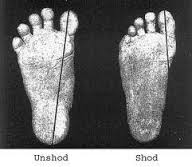
There is nothing like a good argument to encourage the questioning of one’s beliefs. The results can only be positive for those who take this challenge: either our views are correct, and we now have the justification for holding them; or they are partially, possibly even wholly false and we can now remove these erroneous beliefs after recognizing them as roadblocks in our attempt to understand the issue in question.
For most of us who support this site, once upon a time we probably agreed with the proposition: “It is necessary to cushion and support our feet when running.” I did, and it wasn’t until the advice given to me based upon this statement proved to be unsatisfactory that I became interested in challenging my beliefs about running shoes, at first, and eventually about all footwear.
Although it is possible to make progress alone when challenging social norms, it is reassuring to have some support from alternate authorities. I was helped significantly by reading the articles and books by researchers who had already attempted to answer the questions I had asked. In this new section, which will appear with some regularity, I’ll introduce some of these works and provide a link, so you can read them for yourself and make your own judgments. These articles will be about feet, footwear, running biomechanics, and related topics. (If you want to suggest an article for this series, simply include the title and source in a comment.)
We’ll begin with “Conclusions from a Comparative Study of the Feet of Barefooted and Shoe-wearing Peoples”, written by Philip Hoffmann, M.D., and published in the American Journal of Orthopedic Surgery in October 1905.
Dr. Hoffmann was fortunate to live in St. Louis, Missouri, my home town and the gateway to the west (or east, north, and south, depending upon your orientation), because the 1904 St. Louis World’s Fair included many “exhibits” and “villages”, which featured native unshod “natives” from populations around the world. (Note: Some of the language and attitudes of Dr. Hoffmann might seem a bit condescending to us, but he lived in a different era and his conclusions are still valid).
These were a few of Hoffmann’s interesting conclusions:
“Shoes as they are usually worn, not only deform but interfere with the functions of the foot by restricting the movement of its many small joints. Their action is more or less that of a splint.” (p. 116)
“It is very significant that in the one hundred eighty six pairs of primitive feet examined, I did not find a single foot associated with the symptoms of weakness so characteristic and common in adult shoe-wearing feet, which are weakened by the restraint the shoe exerts over function.” (p. 123)
“The children of shoe-wearers inherit the same type of foot as do those of barefooted races, and this type is changed only in so far as footwear modifies it. (p. 135)
Enjoy the article!
